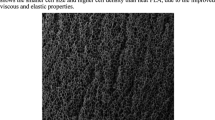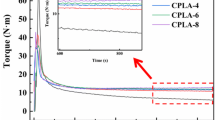Abstract
In this work, a chain extender (CE) was added to polylactide (PLA) to improve its foamability. The steady and transient rheological properties of neat PLA and CE-treated PLA revealed that the introduction of the CE profoundly affected the melt viscosity and elasticity. The linear viscoelastic properties of CE-enriched PLA suggested that a long-chain branching (LCB) structure was formed from the reaction with the CE. LCB-PLA exhibited an increased viscosity, more shear sensitivity, and longer relaxation time in comparison with the linear PLA. The LCB structure was also found to affect the transient shear stress growth and elongational flow behavior. LCB-PLA exhibited a pronounced strain hardening, whereas no strain hardening was observed for the linear PLA. Batch foaming of the linear and LCB-PLAs was also examined at foaming temperatures of 130, 140, and 155 °C. The LCB structure significantly increased the integrity of the cells, cell density, and void fraction.







Similar content being viewed by others
References
Airale A, Carello M, Scattina A (2011) Carbon fiber monocoque for a hydrogen prototype for low consumption challenge. Mater Wiss Werkst 42:386–392. doi:10.1002/mawe.201100793
Carreau PJ, De Kee DCR, Chhabra RP (1997) Rheology of polymeric systems principles and applications. Hanser-Garner Publications
Coppola S, Acierno S, Grizzuti N, Vlassopoulos D (2006) Viscoelastic behavior of semicrystalline thermoplastic polymers during the early stages of crystallization. Macromolecules 39:1507–1514. doi:10.1021/ma0518510
Di Y, Iannace S, Di Maio E, Nicolais L (2005) Reactively modified poly(lactic acid): properties and foam processing. Macromol Mater Eng 290:1083–1090. doi:10.1002/mame.200500115
Drumright RE, Gruber PR, Henton DE (2000) Polylactic acid technology. Adv Mater 12:1841–1846. doi:10.1002/1521-4095(200012)12:23<1841::aid-adma1841>3.0.co;2-e
Eslami H, Kamal MR (2013) Effect of a chain extender on the rheological and mechanical properties of biodegradable poly(lactic acid)/poly[(butylene succinate)-co-adipate] blends. J Appl Polym Sci 129:2418–2428. doi:10.1002/app.38449
Fujimoto Y, Ray SS, Okamoto M, Ogami A, Yamada K, Ueda K (2003) Well-controlled biodegradable nanocomposite foams: from microcellular to nanocellular. Macromol Rapid Commun 24:457–461. doi:10.1002/marc.200390068
Garancher J-P, Fernyhough A (2012) Crystallinity effects in polylactic acid-based foams. J Cell Plast 48:387–397. doi:10.1177/0021955x12448804
Garlotta D (2001) A literature review of poly(lactic acid). J Polym Environ 9:63–84
Gendron R (ed) (2005) Thermoplastic foam processing, principles and development. CRC Press
Gong W, Mai Y, Zhou Y, Qi N, Wang B, Yan D (2005) Effect of the degree of branching on atomic-scale free volume in hyperbranched poly[3-ethyl-3-(hydroxymethyl)oxetane]. A positron study. Macromolecules 38:9644–9649. doi:10.1021/ma051026j
He C, Wood-Adams P, Dealy JM (2004) Broad frequency range characterization of molten polymers. J Rheol 48:711–724. doi:10.1122/1.1763943
Keshtkar M, Nofar M, Majithiya K, Park CB, Carreau P (2011) Foaming behavior of PLA/nanocolay nanocomposites in continious extrusion. In: BioFoams, Itally
Kramschuster A, Turng L-S (2009) An injection molding process for manufacturing highly porous and interconnected biodegradable polymer matrices for use as tissue engineering scaffolds. J Biomed Mater Res Part B Appl Biomater 92B:366–376. doi:10.1002/jbm.b.31523
Lee JWS, Park CB (2006) Use of nitrogen as a blowing agent for the production of fine-celled high-density polyethylene foams. Macromol Mater Eng 291:1233–1244. doi:10.1002/mame.200600203
Lee ST, Ramesh NS (eds) (2004) Polymeric foams: mechanisms and materials. CRC Press LLC
Lee JWS, Wang K, Park CB (2005) Challenge to extrusion of low-density microcellular polycarbonate foams using supercritical carbon dioxide. Ind Eng Chem Res 44:92–99. doi:10.1021/ie0400402
Lunt J (1998) Large-scale production, properties and commercial applications of polylactic acid polymers. Polym Degrad Stab 59:145–152. doi:10.1016/S0141-3910(97)00148-1
Mahmood SH, Keshtkar M, Park CB (2014) Determination of carbon dioxide solubility in polylactide acid with accurate PVT properties. J Chem Thermodyn 70:13–23. doi:10.1016/j.jct.2013.10.019
Mahmoodi M, Behravesh AH, Rezavand SAM, Golzar M (2009) Theoretical and visual study of bubble dynamics in foam injection molding. Polym Eng Sci 50:561–569. doi:10.1002/pen.21565
Matuana LM, Diaz CA (2013) Strategy to produce microcellular foamed poly(lactic acid)/wood-flour composites in a continuous extrusion process. Ind Eng Chem Res 52:12032–12040
Mihai M, Huneault MA, Favis BD (2010) Rheology and extrusion foaming of chain-branched poly(lactic acid). Polym Eng Sci 50:629–642
Minegishi A, Nishioka A, Takahashi T, Masubuchi Y, Takimoto J-i, Koyama K (2001) Uniaxial elongational viscosity of PS/a small amount of UHMW-PS blends. Rheol Acta 40:329–338. doi:10.1007/s003970100165
Mitomo H, Kaneda A, Quynh TM, Nagasawa N, Yoshii F (2005) Improvement of heat stability of poly(l-lactic acid) by radiation-induced crosslinking. Polymer 46:4695–4703
Naguib HE, Park CB, Panzer U, Reichelt N (2002) Strategies for achieving ultra low-density polypropylene foams. Polym Eng Sci 42:1481–1492. doi:10.1002/pen.11045
Naguib HE, Park CB, Reichelt N (2004) Fundamental foaming mechanisms governing the volume expansion of extruded polypropylene foams. J Appl Polym Sci 91:2661–2668. doi:10.1002/app.13448
Najafi N, Heuzey MC, Carreau PJ, Wood-Adams PM (2012) Control of thermal degradation of polylactide (PLA)-clay nanocomposites using chain extenders. Polym Degrad Stab 97:554–565. doi:10.1016/j.polymdegradstab.2012.01.016
Nofar M, Park CB (2014) Poly (lactic acid) foaming: a review. Prog Polym Sci. doi:10.1016/j.progpolymsci.2014.04.001
Nofar M, Barzegari MR, Tabatabae iA, Keshtkar M, Park CB (2012) Effect of various additives (talc, nanoclay, and nanosilica) on extrusion foaming of pla through crystallization. Paper presented at the Annual Technical Conference - ANTEC
Nofar M, Tabatabaei A, Ameli A, Park CB (2013) Comparison of melting and crystallization behaviors of polylactide under high-pressure CO2, N2, and He. Polymer 54:6471–6478
Park CB, Baldwin DF, Suh NP (1995) Effect of the pressure drop rate on cell nucleation in continuous processing of microcellular polymers. Polym Eng Sci 35:432–440. doi:10.1002/pen.760350509
Pilla S, Kim SG, Auer GK, Gong S, Park CB (2009) Microcellular extrusion-foaming of polylactide with chain-extender. Polym Eng Sci 49:1653–1660. doi:10.1002/pen.21385
Pilla S, Kim SG, Auer GK, Gong S, Park CB (2010a) Microcellular extrusion foaming of poly(lactide)/poly(butylene adipate-co-terephthalate) blends. Mater Sci Eng 30:255–262
Pilla S, Kramschuster A, Lee J, Clemons C, Gong S, Turng L-S (2010b) Microcellular processing of polylactide–hyperbranched polyester–nanoclay composites. J Mater Sci 45:2732–2746
Robertson CG, Roland CM, Puskas JE (2002) Nonlinear rheology of hyperbranched polyisobutylene. J Rheol 46:307–320. doi:10.1122/1.1428318
Seo J-H, Han J, Lee KS, Cha SW (2012) Combined effects of chemical and microcellular foaming on foaming characteristics of PLA (poly lactic acid) in injection molding process. Polym Plast Technol Eng 51:455–460. doi:10.1080/03602559.2011.651239
So K (2012) Automotive giants turn to bioplastics. Eur Plast News 39:31–32
Soppimath KS, Aminabhavi TM, Kulkarni AR, Rudzinski WE (2001) Biodegradable polymeric nanoparticles as drug delivery devices. J Control Release 70:1–20. doi:10.1016/S0168-3659(00)00339-4
Spitael P, Macosko CW (2004) Strain hardening in polypropylenes and its role in extrusion foaming. Polym Eng Sci 44:2090–2100. doi:10.1002/pen.20214
Taki K, Kitano D, Ohshima M (2011) Effect of growing crystalline phase on bubble nucleation in poly(l-lactide)/CO2 batch foaming. Ind Eng Chem Res 50:3247–3252
Theinsathid P, Chandrachai A, Keeratipibul S (2009) Managing bioplastics business innovation in start up phase 2009. 4:82–93
Tian J, Yu W, Zhou C (2006) The preparation and rheology characterization of long chain branching polypropylene. Polymer 47:7962–7969. doi:10.1016/j.polymer.2006.09.042
Van Ruymbeke E, Keunings R, Bailly C (2005) Prediction of linear viscoelastic properties for polydisperse mixtures of entangled star and linear polymers: modified tube-based model and comparison with experimental results. J Non-Newtonian Fluid 128:7–22. doi:10.1016/j.jnnfm.2005.01.006
Wang J, Zhu W, Zhang H, Park CB (2012a) Continuous processing of low-density, microcellular poly(lactic acid) foams with controlled cell morphology and crystallinity. Chem Eng Sci 75:390–399
Wang L, Jing X, Cheng H, Hu X, Yang L, Huang Y (2012b) Blends of linear and long-chain branched poly(l-lactide)s with high melt strength and fast crystallization rate. Ind Eng Chem Res 51:10088–10099. doi:10.1021/ie300526u
Wang L, Jing X, Cheng H, Hu X, Yang L, Huang Y (2012c) Rheology and crystallization of long-chain branched poly(l-lactide)s with controlled branch length. Ind Eng Chem Res 51:10731–10741. doi:10.1021/ie300524j
Wang L, Wan D, Qiu J, Tang T (2012d) Effects of long chain branches on the crystallization and foaming behaviors of polypropylene-g-poly(ethylene-co-1-butene) graft copolymers with well-defined molecular structures. Polymer 53:4737–4757
Wever DAZ, Picchioni F, Broekhuis AA (2013) Branched polyacrylamides: synthesis and effect of molecular architecture on solution rheology. Eur Polym J 49:3289–3301. doi:10.1016/j.eurpolymj.2013.06.036
Wong A, Leung SN, Li GYG, Park CB (2007) Role of processing temperature in polystyrene and polycarbonate foaming with carbon dioxide. Ind Eng Chem Res 46:7107–7116. doi:10.1021/ie070551z
Wong A, Guo Y, Park CB (2013) Fundamental mechanisms of cell nucleation in polypropylene foaming with supercritical carbon dioxide effects of extensional stresses and crystals. J Supercrit Fluids 79:142–151. doi:10.1016/j.supflu.2013.02.013
Wood-Adams PM, Dealy JM, deGroot AW, Redwine OD (2000) Effect of molecular structure on the linear viscoelastic behavior of polyethylene. Macromolecules 33:7489–7499. doi:10.1021/ma991533z
You J, Lou L, Yu W, Zhou C (2013) The preparation and crystallization of long chain branching polylactide made by melt radicals reaction. J Appl Polym Sci 129:1959–1970. doi:10.1002/app.38912
Zhu W, Zhou N, Wu H (2006) Multiplex shear stress-induced nucleation in dynamic microcellular foaming process. Polym Eng Sci 46:1728–1738. doi:10.1002/pen.20651
Acknowledgments
Financial support from AUTO21 (Canada’s automotive R&D program) and NCE (Networks of Centres of Excellence of Canada) is gratefully acknowledged.
Author information
Authors and Affiliations
Corresponding author
Rights and permissions
About this article
Cite this article
Najafi, N., Heuzey, MC., Carreau, P.J. et al. Rheological and foaming behavior of linear and branched polylactides. Rheol Acta 53, 779–790 (2014). https://doi.org/10.1007/s00397-014-0801-3
Received:
Revised:
Accepted:
Published:
Issue Date:
DOI: https://doi.org/10.1007/s00397-014-0801-3




